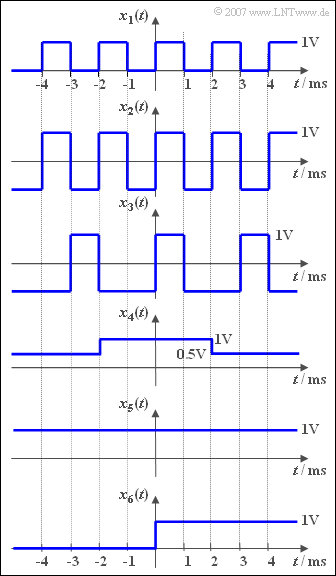Exercise 2.2: DC Component of Signals
From LNTwww
The graph shows some time signals defined for all times $($from $-\infty$ to $+\infty)$ . For all six sample signals $x_i(t)$ the associated spectral function can be written as:
- $$X_i(f)=A_0\cdot{\rm \delta}(f)+\Delta X_i(f).$$
Here
- $A_0$ is the DC component, and
- $\Delta X_i(f)$ is the spectrum of the residual signal reduced by the DC component $\Delta x_i(t) = x_i(t) - A_0$.
Hint:
- This exercise belongs to the chapter Direct Current Signal - Limit Case of a Periodic Signal.
Questions
Solution
(1) The correct answers are 1, 3, 4, 5 and 6.
- All signals except $x_2(t)$ contain a DC signal component.
(2) Only solution 5 is correct:
- If the DC component $1\text{V}$ is subtracted from the signal $x_5(t)$ , the residual signal $\Delta x_5(t) = x5(t) - 1\text{V}$ is equal to zero.
- Accordignly, the spectral function is $\Delta X_5(f) = 0$.
- For all other time courses $\Delta x_i(t)$ is not equal to zero and thus the associated spectral function $\Delta X_i(f)$ is also not equal to zero.
(3) With a periodic signal, averaging over a period duration is sufficient to calculate the DC signal component $A_0$ .
- Beim Beispielsignal $x_3(t)$ ist diese $T_0 = 3\,\text{ms}$. Damit ergibt sich der gesuchte Gleichanteil zu
- $$A_0=\rm \frac{1}{3\,ms}\cdot \big[1\,V\cdot 1\,ms+(-1\,V)\cdot 2\,ms \big] \hspace{0.15cm}\underline{=-0.333\,V}.$$
(4) Für das Signal $x_4(t)$ kann geschrieben werden: $x_4(t) = 0.5 \,{\rm V} + Δx_4(t)$.
- Hierbei bezeichnet $Δx_4(t)$ einen Rechteckimpuls mit Amplitude $0.5 \,{\rm V} $ und Dauer $4 \,{\rm ms} $, der wegen seiner endlichen Dauer nicht zum Gleichsignalanteil beiträgt.
- Deshalb gilt hier $A_0 \hspace{0.15cm}\underline{=0.5 \,{\rm V}}$.
(5) Die allgemeine Gleichung zur Berechnung des Gleichsignalanteils lautet:
- $$A_0=\lim_{T_{\rm M}\to \infty}\frac{1}{T_{\rm M}}\int_{-T_{\rm M}/2}^{+T_{\rm M}/2}x(t)\, {\rm d }t.$$
- Spaltet man dieses Integral in zwei Teilintegrale auf, so erhält man:
- $$A_0=\lim_{T_{\rm M}\to \infty}\frac{1}{T_{\rm M}}\int _{-T_{\rm M}/2}^{0}0 {\rm V} \cdot\, {\rm d } {\it t }+\lim_{T_{\rm M}\to \infty}\frac{1}{T_{\rm M}}\int _{0}^{+T_{\rm M}/2}1 \rm V \ {\rm d }{\it t }.$$
- Nur der zweite Term liefert einen Beitrag. Daraus folgt wiederum $A_0 \hspace{0.15cm}\underline{=0.5 \,{\rm V}}$.
